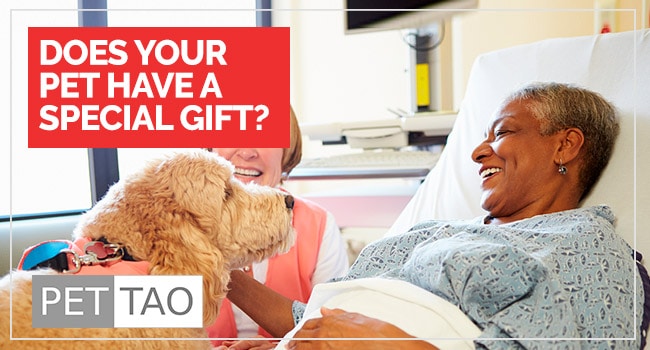According to a study published by the National Institutes of Health: Hospitalized human patients exposed to a therapy animal had significant decreases in pain, negative mood state, anxiety and fatigue, and a significant increase in perceived energy level.
The authors of the study theorized pet therapy, a low-tech and low-cost therapy, improves mood and emotional health in hospitalized human patients.
Does this sound like something for which you and your pet are well-suited?
You love all animals, but you knew there was something special about Fluffy.
Fluffy never barks or growls, loves children, and is well behaved!
Neighborhood children love Fluffy, and Fluffy enjoys the company.
Fluffy’s presence could be beneficial to others. Plus, it would be rewarding for you to see Fluffy help people!
Maybe Fluffy could become a service dog!
But what does that entail? Does Fluffy need to take classes? How much training will he need? How much of YOUR time does this pursuit need?
And, is it all worth it?
Here is how to navigate service dog registration.
What Does It Take to Turn Your Dog into a Service Dog?
Therapy animals have the ability to bring harmony and balance to people’s lives – especially those who can benefit the most. And the outcome is rewarding for you as well!
Seeing the joy on peoples’ faces after they spend time with Fluffy will feel great!
But, what does it take?
Step One
Find a reputable certifying organization. The Good Dog Foundation is one of the most popular training programs.
Rachel McPherson, founder and executive director of The Good Dog Foundation, is also the author of “Every Dog Has a Gift: True Stories of Dogs Who Bring Hope & Healing Into Our Lives.”
The Foundation provides animal owners with evaluation, training, and follow-up programs.
A class participation fee covers all expenses. The fee for most organizations is between $100-$150. Insurance covers volunteers on all official Good Dog visits.
Step Two
Animal-handler teams are pre-screened. During this session, a certified Good Dog trainer observes your pet’s temperament, energy level, sociability with humans and other dogs, and relationship with his handler.
The handler must show proper handling technique, willingness to follow The Good Dog Foundation training schedule, and willingness to follow policies of the facilities.
After the evaluation, the Foundation determines which class is most appropriate. These classes include fundamental obedience, basic obedience, and therapy dog classes.
Are nervous or excited pets excluded from participating in therapy service work?
Nope! Gentle, loving dogs that have a temporary problem with manners due to nerves are still considered.
How much time should you expect to complete these courses?
Fundamental Service Dog Training: Four One-Hour Sessions
- Basic obedience (sit, down, stay, walk on a loose lead)
- Relaxation and control
- This course is for dogs with no prior training.
- The dog must be at least four months old.
Basic Service Dog Training: Four One-Hour Sessions
- Basic obedience (sit, down, stand, stay, walk on a loose lead)
- Begin gentling exercises and desensitization to handling and novel stimuli
- Begin familiarization with hospital equipment
- Socialization exercises with other dogs and people
Therapy Service Dog Training: Five one-hour sessions
- Meeting and greeting exercises
- Familiarization with hospital equipment
- Role-playing for the hospital environment
- Instruction and coaching on safe dog-handling in health care facilities
Once the pair passes the class, a veterinarian must clear the dog for work, which includes a medical and vaccination history and an assessment of the dog by a veterinarian.
Then, certified pairs will continue to receive support from the Foundation’s staff.
Step Three
The Foundation will assist handlers and therapy animals with finding the right facility to serve.
Each facility has a relationship with the Foundation, ensuring handler-dog therapy teams always feel welcome and secure. The Foundation assesses facilities to help handlers select the places they prefer to visit.
Also, experienced handler-dog teams go with new teams on their first walk-through of a new facility.
The Foundation continues to offer follow-up support after certification. Volunteers are welcome to ask for help from the Foundation’s peer support groups.
The Foundation also hosts events to recognize volunteers for their service.
Additionally, Good Dog re-certifies its therapy teams on an annual basis. Recertification allows the Foundation to provide consistent and up-to-date care to all its patients. To be re-certified, teams are re-evaluated on therapy skills and temperament by a trainer.
Where Can You and Your Therapy Animal Volunteer?
Therapy animals can volunteer at a variety of places!
Everywhere from children’s storytime at the local library, to hospitals, to Veteran’s Affairs!
Countless studies describe the benefits of therapy animals or service dogs on people in need.
Learn How to Cook for Your Beloved Service Dog! Recipes Included!








